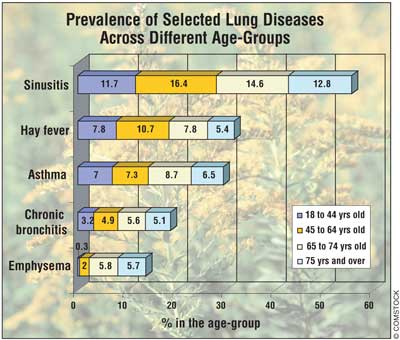US Pharm.
2007;32(7):10.
The 2005 National Health
Interview Survey conducted by the CDC provides insights into the health
conditions prevalent among noninstitutionalized Americans. Of the lung
diseases shown in the graph, sinusitis had the highest prevalence in 2005,
affecting 29.52 million (13.4%) Americans, followed by hay fever (18.65
million; 8.6%), asthma (15.7 million; 7.2%), and chronic obstructive pulmonary
disease (COPD) (12.7 million; 5.8%). COPD comprises a large group of lung
diseases, including emphysema and chronic bronchitis, which are characterized
by blockage of airflow that prevents normal breathing. Of those who had COPD,
8.9 million (4.1%) Americans had chronic bronchitis and 3.8 million (1.7) had
emphysema. Excluding emphysema, all of these selected lung diseases were more
prevalent in females than in males.

Race:
Studies have shown that Asians have lower rates of asthma than most racial
groups. Although there are limited data on COPD, studies have shown that
Asians may have a genetic component that reduces their risk of COPD. Native
Hawaiian or other Pacific Islander adults had asthma rates more than double
those for any other racial group. Hispanic adults had lower rates of
emphysema, hay fever, asthma, sinusitis, and chronic bronchitis than white
adults and had lower rates for asthma, sinusitis, and chronic bronchitis than
did black adults. In general, Hispanics have lower prevalence and death rates
due to asthma than black or white adults. Among all racial groups, Mexican
Americans have the lowest asthma mortality and prevalence rates.
Employment:
More than 20 million
workers in the United States are exposed to gases, vapors, fumes, and dusts
that can cause COPD. A study by the CDC concluded that 19% of COPD cases are
attributable to work in industries that pose a risk for these illnesses.
Adults in poor families had higher rates of emphysema, asthma, and chronic
bronchitis than adults in families that were not poor. However, the opposite
pattern was seen for hay fever.
Insurance:
Of adults younger than
65, those insured by Medicaid had higher percentages of emphysema, asthma, and
chronic bronchitis than those with private insurance or those who were
uninsured. Similarly, in adults 65 and older, those covered by Medicaid and
Medicare had higher rates of emphysema, asthma, and chronic bronchitis than
did adults covered by Medicare alone.
Although chronic respiratory
diseases are among the most common and costly health problems, these
conditions are also among the most preventable, from progression to advanced
stages. Adopting healthy behaviors, such as avoiding tobacco use or
controlling the effects of the disease by seeking professional guidance, can
help patients lead a relatively healthy life. Health care practitioners need
to be conversant with the trends of these diseases.
To comment on this article, contact
editor@uspharmacist.com.






